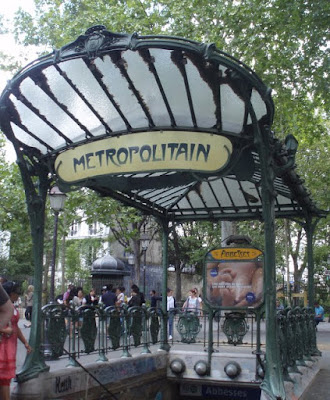Fans of the movie "Amelie" will recognize some of the photos we took today around Montmartre. It's a bohemian, artsy kind of place, but it has its share of quiet photogenic residential streets as well.
We started our stroll at the Blanche metro stop and were greeted with a view of the iconic Moulin Rouge, a cabaret where dinner and a show will set you back 150 euros or more per person.
We continued up on the haphazardly twisty Rue Lepic, past shops and cafes.
We did walk past the Tabac des Deux Moulins (where Amelie worked in the film) but it appeared to be permanently closed. Also it was so unphotogenic that it did not occur to me to take a picture...sorry about that!
We noticed this odd sculpture in a small park on Rue Girardon. It's from a short story by Marcel Ayme about a man who can walk through walls, "Le Passe Muraille".
 |
| Some wiseguy gave the statue a manicure. |
We have seen these strange stickers throughout the city.
 |
| To Kevin's credit, he took this picture under protest. |
The Rue de l'Abreuvoir is straight out of a fairy tale.
Around the corner is the only vineyard left within Paris's city limits. The Clos Montmartre vines are harvested each October and they celebrate the vendange with a big party.
 |
| The vineyard with a small flower garden in the foreground. |
Just across the street is a nightclub called Au Lapin Agile - it was a popular hangout for intellectuals and artists in the early 20th century.
More street views of the Rue des Seules.
 |
| Surreal doorknocker, Rue des Seules |
Turning down the Rue Lamarck, we caught a first view of the white domes of Sacré
Coeur.
Up until this point we felt like we had all of Montmartre to ourselves since we had seen very few tourist crowds, but once we got to the Place Tertre we found our fellow tourists out in full force. For a breather, we stepped into the 12th century church of St. Pierre de Montmartre.
We then made our way to the Espace
Dalí, which is a museum dedicated to the works of the surrealist artist. My only knowledge of his work consists of the few melting watch slides I'd seen in a college art history class. That seems to definitely be a theme in his work.
Judging from the works on display and a short art video of the wild-eyed, mustachioed artist himself, the mind of Dalí was a very bizarre one.
And finally we reach the church of Sacré Coeur at the top of the Butte Montmartre.
Photo taking was prohibited inside; we're not sure why. It doesn't matter; I found the outside of the church much more noteworthy than the interior. At least it would have been, had there not been some kind of ski jump/bike ramp scaffolding all down the hill in front.
We then made our way to the Abbesses Metro stop, passing the carousel below Sacré Coeur (also seen in "Amelie"). A long, but satisfying, walk!


















































